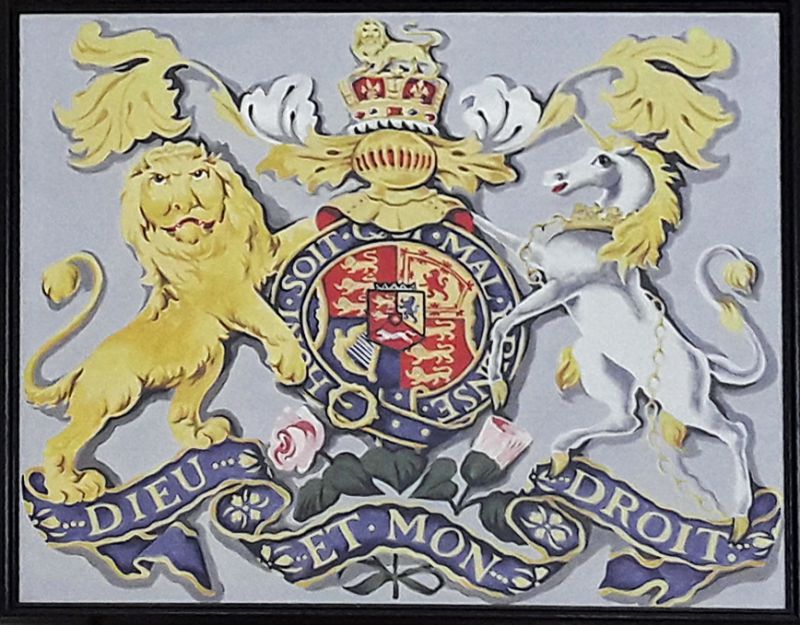
The Coat of Arms over the North door, now the door into the new kitchen, belongs to the reign of George III (1760 - 1820), and probably dates to sometime after the King's accession. The original was restored in 1967, however, this is a modern copy.
This Coat of Arms was stolen on 2nd February 2002 and replaced by the Arms we see today. Designed by Denise Andrews and printed by Stuart Morris, it is a photograph of the arms of George III hanging over the north door of East Mersea Parish Church. Alan Ellis St Mary the Virgin, Peldon
We have no photographs of the original and we owe the dating of the stolen Coats of Arms to the entry written in the church guide, St Mary The Virgin, Peldon, by the Reverend Gough in 1970.
The Coat of Arms, over the North Door, belongs to the reign of George III, and probably dates from the late
1700s... An Act of Edward VI laid down that all churches should carry the Royal Coat of Arms, and an old Churchwarden's receipt shows an entry
August the 1st, 1739, by Samuel Bullock:
For the Crown in the Arch: 12/8d
This perhaps refers to the previous Coat of Arms or Royal Crown
Often Coats of Arms were painted over and re-done as the Monarch changed his or her Arms so it is likely that the earlier Coat of Arms, apparently repaired by the Peldon carpenter, Samuel Bullock, were those of George I and II.
In 1739, the date of the receipt, the British monarch was George II whose arms were the same as his father's, George I. With changes to the Coat of Arms following George III's accession (the grandson of George II) the Peldon arms must have been replaced, or repainted, sometime after 1760.
It became compulsory to put up Royal Coats of Arms in churches after the Reformation, maybe a reminder to the congregation that it was the King who was now head of the Church and not the Pope. Most surviving examples date from Edward VI's reign onwards, those of certain monarchs are less common than others especially those of his father Henry VIII or Elizabeth I. The Coats of Arms were usually put above where the rood screen stood or on the arch of the chancel and were generally painted or carved. The painted Coats of Arms were usually on a metre square or rectangle of wooden board or on canvas.
Many Arms were taken down and destroyed during the Commonwealth when Cromwell replaced some with the Commonwealth Arms or later the Arms of the Protectorate. Some of those Commonwealth Arms that have survived from that era owe their survival to the fact they were painted on the back of an existing Royal Coat of Arms.
With the restoration of the King, Charles II, Parliament decided to remove the arms of the Commonwealth and replace them with those of the King, although displaying the Royal Coat of Arms was not compulsory. Most surviving Coats of Arms date to after this time.
Just before the restoration of the King, Samuel Pepys in his diary makes an entry on 22nd April 1660
How the King's Arms are every day set up in the houses and churches
It was to be 14th May 1660 that Charles II was officially restored to the throne.

In Peldon's replica of a George III Coat of Arms, the lion to the left represents England and the unicorn to the right, Scotland. Other elements include a shield of four quarters encircled by the garter surmounted by the helmet, mantling, crown and crest and the well-known mottoes of DIEU ET MON DROIT (God and my right) and HONI SOIT QUI MAL Y PENSE (Shame on anyone who thinks evil of it). Within the shield England is represented by the three lions and Scotland by the rampant lion; a harp represents Ireland. The Hanoverian arms, including the white horse of Hanover and a blue lion are in the centre of the coat of arms.
The Hanoverian Arms were added to the Royal Coat of Arms upon the accession of George I. The House of Hanover was a German royal house that ruled Hanover, Great Britain and Ireland at various times during the 17th to the 20th century. (Upon Queen Victoria's accession the Hanoverian escutcheon and crown were removed because, as a woman, the Queen was unable to succeed to the throne of Hanover under Hanoverian law.)
Often the year would be painted in at the bottom in Latin numerals and the initials of the monarch incorporated into the design.
Research has been done into who were the artists who painted Royal Coats of Arms and it would appear that inn signwriters were often employed to paint them!
The most prolific artist in Colchester and surrounding villages was Joseph Wallis whose Coats of Arms were made of wrought iron in his Colchester iron foundry. A good example of a Coat of Arms of his is in the Castle Museum and they appeared in several local churches. His foundry at the west end of Colchester High Street on the north side, was built circa 1792 (he died in 1827). Who painted the Peldon Coat of Arms remains a mystery.
In the mid nineteenth century most churches had Royal Coats of Arms but as churches were restored these very old, often fragile, dark and dirty paintings were taken down and put in storage where they deteriorated before, in one case, being used as firewood! The custom of displaying these Coats of Arms is not, however, consigned to the history books because several dozen have been erected in churches up and down the country during the reign of Elizabeth II.
Peldon History Project
Read More
St Mary the Virgin Peldon by Alan Ellis (PDF file - opens in a new window - 466Kb).
The Bells of St Mary's Peldon
|